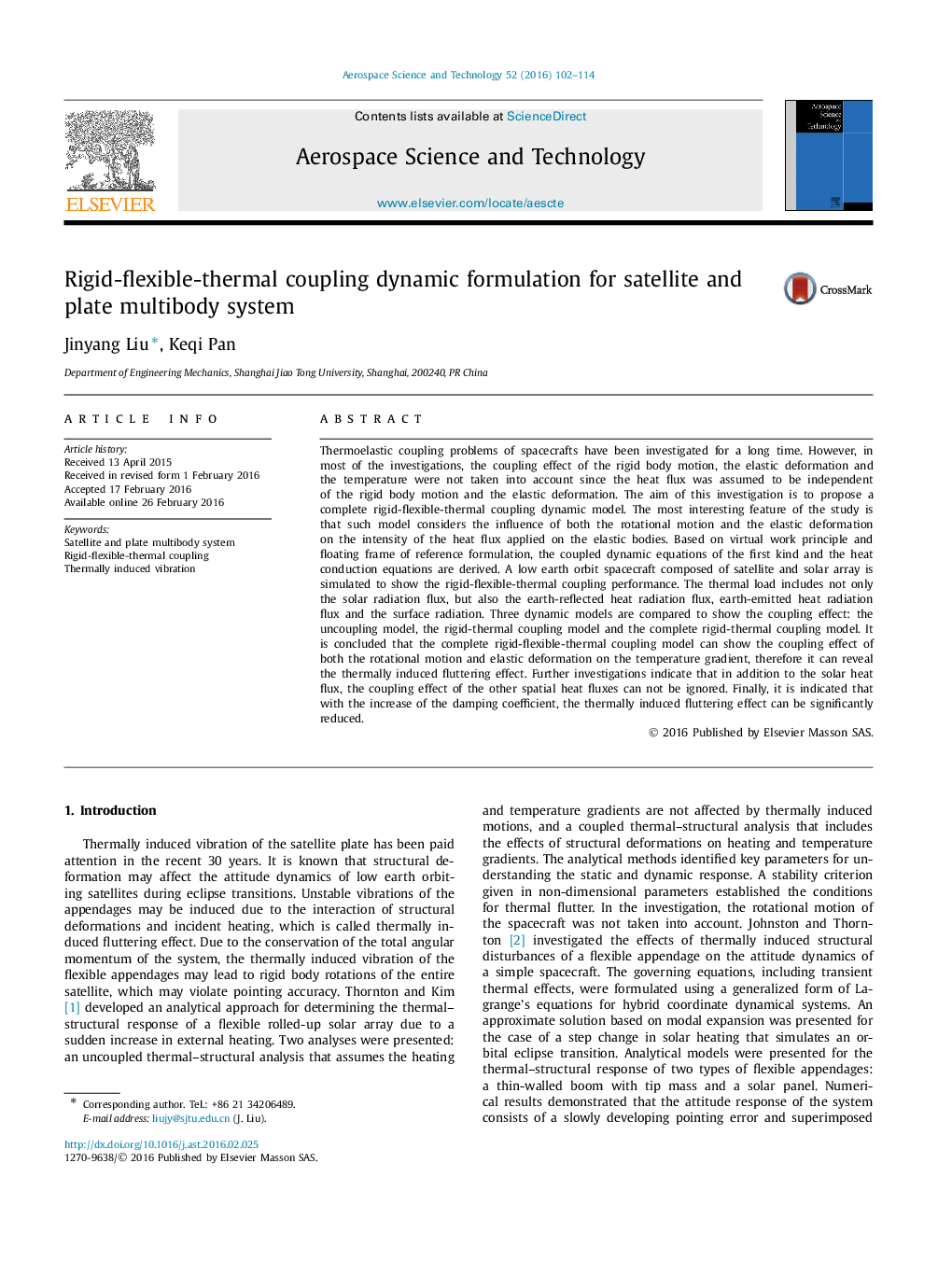| کد مقاله | کد نشریه | سال انتشار | مقاله انگلیسی | نسخه تمام متن |
|---|---|---|---|---|
| 8058628 | 1520082 | 2016 | 13 صفحه PDF | دانلود رایگان |
عنوان انگلیسی مقاله ISI
Rigid-flexible-thermal coupling dynamic formulation for satellite and plate multibody system
ترجمه فارسی عنوان
فرمول پویایی کوپلینگ سفت و انعطاف پذیر برای سیستم چند منظوره ماهواره ای و صفحات
دانلود مقاله + سفارش ترجمه
دانلود مقاله ISI انگلیسی
رایگان برای ایرانیان
کلمات کلیدی
سیستم چندرسانه ای ماهواره ای و صفحه ای، کوپلینگ سفت و سخت انعطاف پذیر، ارتعاش القایی ناشی از حرارتی،
ترجمه چکیده
مسائل مربوط به اتصال ترموالاستیک فضاپیماها برای مدت زمان طولانی مورد بررسی قرار گرفته است. با این حال، در بسیاری از تحقیقات، اثر اتصال از حرکت بدن سفت و محکم، تغییر شکل کششی و درجه حرارت در نظر گرفته نمی شود، زیرا شار حرارتی به طور مستقل از حرکت بدن سفت و تغییر شکل الاستیک است. هدف از این تحقیق، ارائه یک مدل پویای کامل کوپلینگ سفت و انعطاف پذیر است. جالب ترین ویژگی مطالعه این است که چنین مدل تاثیر هر دو حرکت چرخشی و تغییر شکل کششی را بر شدت شار گرما اعمال شده بر روی الاستیک کشف می کند. بر اساس اصل کار مجازی و چارچوب شناور فرمول مرجع، معادلات دینامیکی مرتبط با نوع اول و معادلات هدایت گرمائی حاصل می شود. یک فضاپیمای کم زمین که از ماهواره و آرایه خورشیدی تشکیل شده است، برای نشان دادن عملکرد کوپلینگ سفت و انعطاف پذیر حرارتی شبیه سازی شده است. بار حرارتی شامل نه تنها شار خورشیدی تابش، بلکه شعله شار حرارتی بازتابی از زمین، شار تابش حرارت زمین و تابش سطح است. مدل های سه پویا برای نشان دادن اثر کوپلینگ مقایسه می شوند: مدل جدا سازی، مدل کوپلینگ سفت و سخت و مدل کوپلینگ سفت و سخت کامل. نتیجه گیری می شود که مدل کامل کوپلینگ سفت و انعطاف پذیر و کامل می تواند اثر کوپلینگ هر دو حرکت چرخشی و تغییر شکل الاستیک را بر گرادیان درجه حرارت نشان دهد، بنابراین می تواند اثر فلوتینگ ایجاد شده توسط گرما را نشان دهد. تحقیقات بیشتری نشان می دهد که علاوه بر شار حرارت خورشیدی، اثر اتصال دیگر فضاهای جوی گرم را نمی توان نادیده گرفت. در نهایت، نشان داده شده است که با افزایش ضریب دمایی، اثرات فلوتریپ ناشی از گرما به طور قابل توجهی کاهش می یابد.
موضوعات مرتبط
مهندسی و علوم پایه
سایر رشته های مهندسی
مهندسی هوافضا
چکیده انگلیسی
Thermoelastic coupling problems of spacecrafts have been investigated for a long time. However, in most of the investigations, the coupling effect of the rigid body motion, the elastic deformation and the temperature were not taken into account since the heat flux was assumed to be independent of the rigid body motion and the elastic deformation. The aim of this investigation is to propose a complete rigid-flexible-thermal coupling dynamic model. The most interesting feature of the study is that such model considers the influence of both the rotational motion and the elastic deformation on the intensity of the heat flux applied on the elastic bodies. Based on virtual work principle and floating frame of reference formulation, the coupled dynamic equations of the first kind and the heat conduction equations are derived. A low earth orbit spacecraft composed of satellite and solar array is simulated to show the rigid-flexible-thermal coupling performance. The thermal load includes not only the solar radiation flux, but also the earth-reflected heat radiation flux, earth-emitted heat radiation flux and the surface radiation. Three dynamic models are compared to show the coupling effect: the uncoupling model, the rigid-thermal coupling model and the complete rigid-thermal coupling model. It is concluded that the complete rigid-flexible-thermal coupling model can show the coupling effect of both the rotational motion and elastic deformation on the temperature gradient, therefore it can reveal the thermally induced fluttering effect. Further investigations indicate that in addition to the solar heat flux, the coupling effect of the other spatial heat fluxes can not be ignored. Finally, it is indicated that with the increase of the damping coefficient, the thermally induced fluttering effect can be significantly reduced.
ناشر
Database: Elsevier - ScienceDirect (ساینس دایرکت)
Journal: Aerospace Science and Technology - Volume 52, May 2016, Pages 102-114
Journal: Aerospace Science and Technology - Volume 52, May 2016, Pages 102-114
نویسندگان
Jinyang Liu, Keqi Pan,
